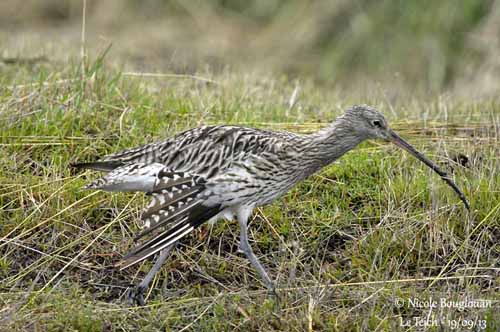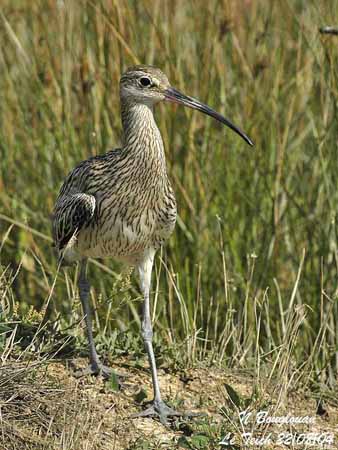
Fr: Courlis cendré
All: Großer Brachvogel
Esp: Zarapito Real
Ita: Chiurlo maggiore
Nd: Wulp
Sd: Storspov
Photographers:
John Anderson
John Anderson Photo Galleries
Aurélien Audevard
OUESSANT DIGISCOPING
Steve Garvie
RAINBIRDER Photo galleries
Ingo Waschkies
Bird Photography
Nicole Bouglouan
PHOTOGRAPHIC RAMBLE
Text by Nicole Bouglouan
Sources:
HANDBOOK OF THE BIRDS OF THE WORLD Vol 3 by Josep del Hoyo-Andrew Elliott-Jordi Sargatal - Lynx Edicions - ISBN : 8487334202
GUIDE DES LIMICOLES de D. Taylor - Delachaux et Niestlé - ISBN : 2603014080
THE HANDBOOK OF BIRD IDENTIFICATION FOR EUROPE AND THE WESTERN PALEARCTIC by Mark Beaman, Steve Madge - C.Helm - ISBN: 0713639601
BIRDS OF THE MIDDLE EAST by R.F. Porter, S. Christensen, P Schiermacker-Ansen C.Helm - ISBN: 0713670169
BIRDS OF THE GAMBIA AND SENEGAL by Clive Barlow and Tim Wacher – Helm Field guides – ISBN: 0713675497
BirdLife International (BirdLife International)
Department of Sustainability, Environment, Water, Population and Communities
What Bird-The ultimate Bird Guide (Mitchell Waite)
Wikipedia, the free encyclopaedia
Eurasian Curlew
Numenius arquata
Charadriiformes Order – Scolopacidae Family
INTRODUCTION :
The Eurasian Curlew is one of the largest waders of the world, and the largest in Europe. This migratory species is highly gregarious outside the breeding season. Its distinctive long, downcurved bill allows the bird to probe deeply into the wet soils of its favourite habitats. Its evocative call is a loud “curloo-oo”, giving the species its name.
DESCRIPTION OF THE BIRD:
Biometrics:
Length: 50-60 cm – Bill: 15-16 cm
Wingspan: 80-100 cm
Weight: M: 400-1000 g – F: 475-1360 g
The adult in breeding plumage has pale buff-brown head, neck and upper mantle. Head and neck are streaked blackish, whereas the mantle shows dark spots and weak bars. Lower back and rump are white. The tail is barred dark brown. The upperwing is pale buff-brown and spotted dark, whereas the flight feathers are blackish.
On the underparts, the whitish upperbreast is streaked dark, but the lower part is more heavily streaked. Belly, vent and undertail-coverts are white with narrow dark streaks. The underwing is white with variable streaking and spotting. Flanks show dark V-shaped streaks.

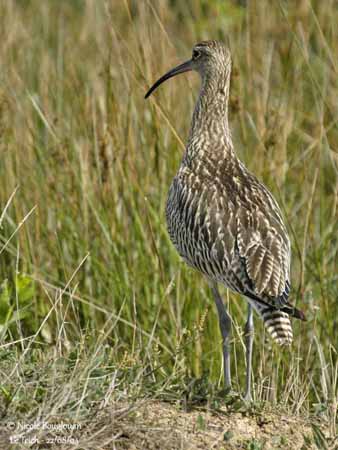
On the finely streaked head, we can see an indistinct white supercilium. Chin and upperthroat are whitish.
The long, downcurved bill is dark horn with pinkish base of lower mandible. The eyes are dark brown. Long legs and feet are pale blue-grey to greenish-grey.
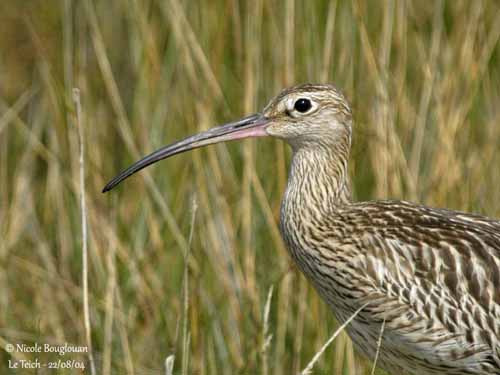
In non-breeding plumage, it is duller and lacks the buff colour, making it greyer overall. Both sexes are similar in plumage, but the female is larger and has longer bill.
The juvenile has more buff on breast, and flanks are less streaked. The upperparts show buff spotting and fringes. It can breed at two years old.
SUBSPECIES AND RANGE:
We can find two recognized subspecies:
N.a. arquata is found in British Islands and France, across W Europe (N to Arctic circle), and E to R Volga and Urals. It winters from Iceland and British Islands, S to Mediterranean and NW Africa, and E to Persian Gulf and W India.
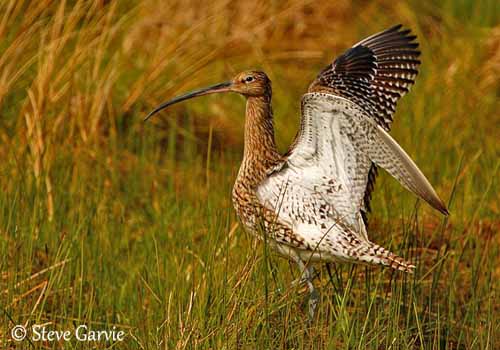
N.a. orientalis breeds in E Urals and winters along African, Asian and SW Japan coasts. This race is larger and paler than nominate, with longer bill and pointed dark streaks on flanks.
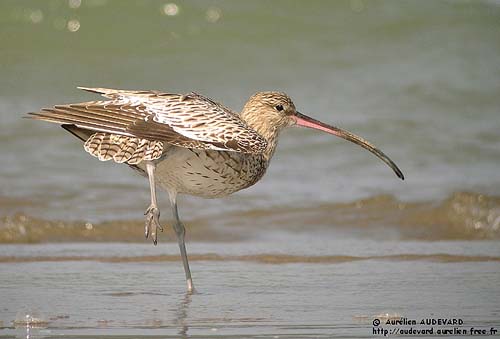
HABITAT:
The Eurasian Curlew breeds in open wet areas such as damp grassland and moorland, bogs, grassy or boggy open areas in forest, farmland, heathland and coastal marshes.
Outside the breeding season, it occurs along muddy coasts, bays and estuaries, on muddy shores of inland lakes and rivers, but also on rocky shores and coastal wetlands.
During migrations, they can be found in wet grassland and fields.
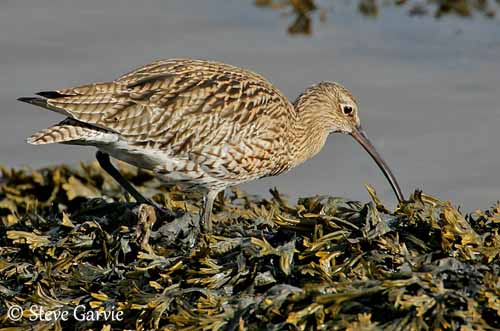
CALLS AND SONGS: SOUNDS BY XENO-CANTO
The Eurasian Curlew gives loud, distinctive “curl-oo” or “cour-lee” usually heard both on breeding and wintering grounds. This call becomes louder and raucous when the bird is alarmed. When excited, it utters a loud, high-pitched “tutututu”. During the courtship displays, we can hear long, trilled, liquid, bubbling phrases, also heard in winter. The flight call is a melodic, slowly rising whistle “duuuweeee”.
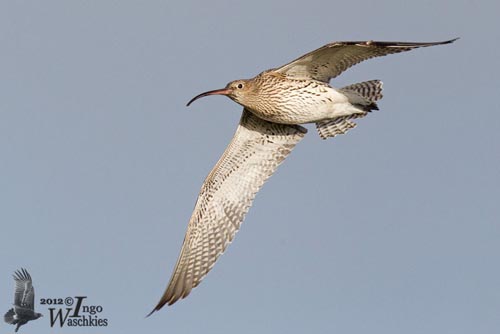
BEHAVIOUR IN THE WILD:
The Eurasian Curlew feeds mainly on annelids, arthropods, crustaceans, molluscs, seeds and berries all year round. But occasionally, it may also take vertebrates such as small fish, amphibians, lizards, young birds and probably eggs, and small rodents. During summer, terrestrial insects and earthworms are primarily consumed.
It forages in deep or shallow water in intertidal zones. It feeds by pecking, jabbing and deep probing in mud or damp soil.
As male and female have different bill length, they forage in separate areas. The female forages on intertidal flats while the male feeds mainly on cultivated grassland. They are usually solitary, walking slowly while foraging. At high tide, larger groups are visible on the elevated banks in creeks.
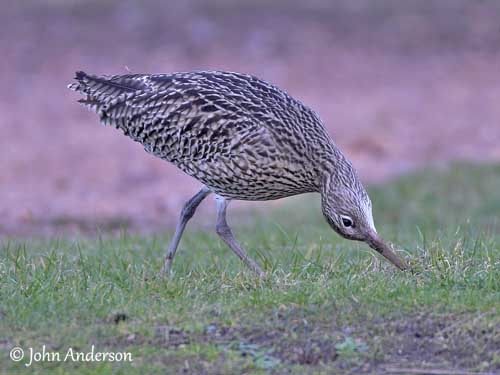
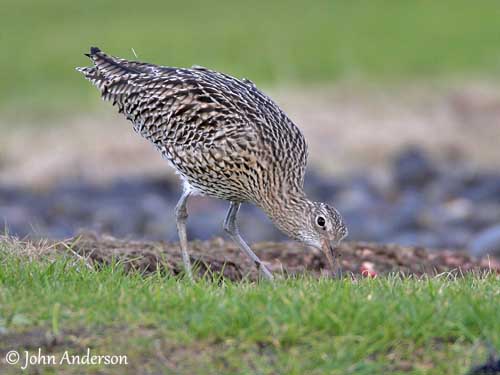
Outside the breeding season, the Eurasian Curlew is highly gregarious. They are monogamous. During the breeding season, the male performs aerial displays. It glides with the wings in wide V-shape, giving quite raptor-like impression when gliding, with invisible long bill. Both parents take part in nesting duties.
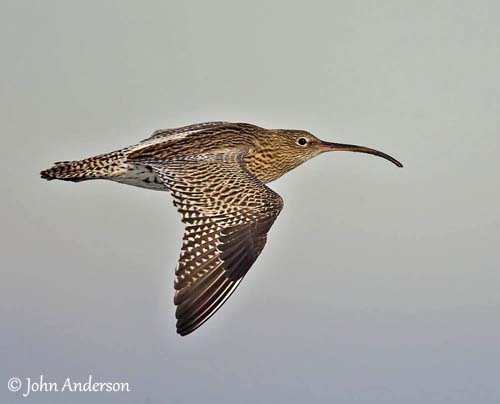
The Eurasian Curlew is a migratory species, although some birds are resident in W of the range, in British Islands and Ireland, and small numbers winter in Iceland and Faeroes.
The nominate race “arquata” winters S as far as Banc d’Arguin (Mauritania), Morocco, Algeria and Italia.
The race “orientalis” winters in rest of African wintering grounds, coming from C Siberia. There is high fidelity to wintering grounds.
The Eurasian Curlew performs relatively slow wingbeats, similar to those of gulls.
REPRODUCTION OF THIS SPECIES:
The breeding season takes place in spring with laying between April and early July.
The Eurasian Curlew nests completely in open or in grass or sedge cover, on tussock or among grass. The nest is a large depression on the ground. The male makes crude scrapes while the female collects material for lining the nest, usually fine grass and some feathers.
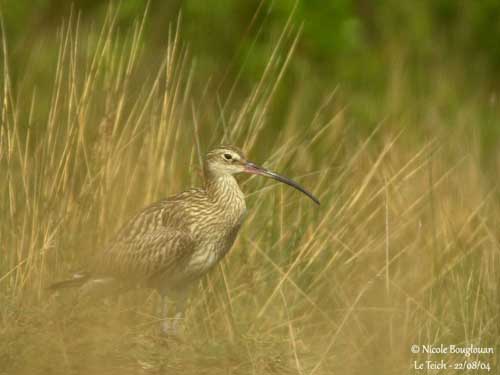
The female lays 4 brownish-olive eggs with dark markings. Both sexes incubate during 27-29 days. At hatching, the downy chicks are pale ochraceous-buff above with dark spots, and the belly is creamy-buff. The crown is black. They are precocial and both parents care for them. They fledge about 32-38 days after hatching.
Nest failure is caused by predation and farming practices.
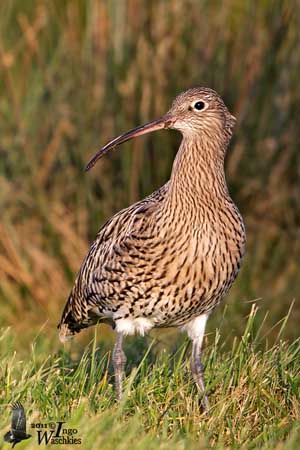
PROTECTION / THREATS / STATUS:
The Eurasian Curlew’s breeding areas are affected by modification and loss of this habitat. Farming practices such as mowing and other mechanized actions destroy numerous nests and chicks. Declines are caused by hunting pressure.
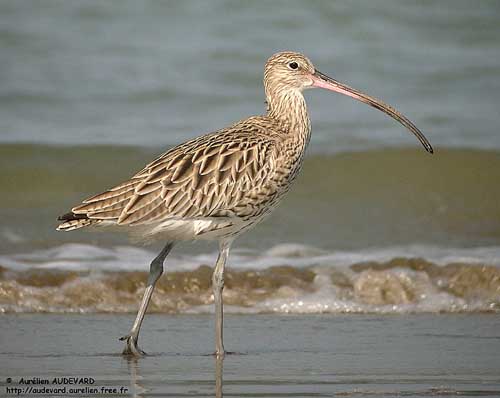
On the wintering grounds, they are disturbed by human developments, pollution and also intensive hunting.
Several protection measures are on their way, and the species occurs in numerous protected areas throughout the range.
But currently, the Eurasian Curlew is evaluated as Near Threatened.
